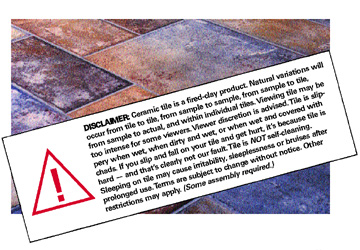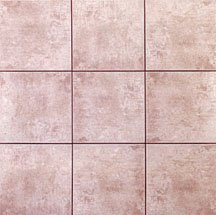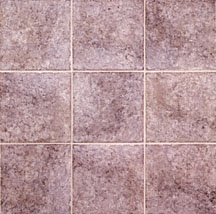
Disclaimers -- can't live with 'em, can't live without 'em. Even though there are perfectly valid times to use them -- to limit liability, for instance -- we shouldn't look to disclaimers as an opportunity to deny or apologize for the inherent variations in ceramic tile. Rather, we should proclaim those variations as something that makes tile unique and distinctive compared to other floor covering materials.
I remember when I first started selling ceramic tile 20 years ago. Back then, shade variation was considered a minor problem. Sure, from time to time the pattern on the tile looked somewhat different, but seldom were we asked to replace a floor because the big orange circle pattern in the middle of the tile was more yellow than orange.
However, today's tiles are specifically created to be unique and to have even more shade variation than in the past. For this we can blame the influence of natural stone. Slate, for instance, has tremendous color, shade and texture variations from tile to tile. And marbles contain various minerals that change the color and structure from tile to tile.
Therein lies the problem. Manufacturers are making ceramic tile to resemble natural stone. In fact, I'd challenge anybody to pick out some of today's really good-looking ceramic tiles from among a group of natural stones.
So, it stands to reason that the more that ceramic tile looks like stone, the more it acquires natural stone characteristics - such as color, texture and shade variations. My point is, don't just disclaim these characteristics that ceramic tile manufacturers have spent millions of dollars to achieve. SELL those variations!
Make no apology for shade variation. Instead, be proud. Hold your head high, stick out your chest and proclaim to the customer, "Your ceramic tile job will be a personalized installation unlike any other in the history of the world. The tile is set by craftsmen who beautifully blend each piece individually and set each tile, one-by-one, to create a unique masterpiece!"
In order to properly sell variation, you must understand the three common types of shade variation. You also need to know the shade variation category of the tile, and ascertain where the tile is going to be installed. Once you have an understanding of all three of these variables, you then can inform the customer of the types of variation that he or she is likely to encounter.
There are three types of shade variation: environmental variation (influenced by lighting, furnishings and other colors); variation from tile to tile (intentional variations manufactured into the product); and variation from sample to actual (variations between production runs). Let's look at each type in greater detail.

If they paint the walls dark blue, their tile will look different. If they have incandescent or natural lighting, the tile will look different than it does under the cool blue fluorescents in your showroom.

If the new shipment is distinctly similar, the tile goes into stock. If new colors have been added or deleted, or if the tile is at all questionable, it should be shown to the sales manager for approval. If the difference is significant, the sales manager should see that all existing samples are changed out - including all customer samples on display.

The best way to make use of the guide is as follows:
1. Rate each stocked floor tile according its variation value. For example, tiles rated V1 would have uniform appearance and minimal variation. V2-rated tiles have slight variation in shade and texture, whereas V3 tiles have moderate variation in shade and texture. Tiles with a V4 rating exhibit random variation in color, texture and overall appearance. Note: You need to have tight control over stock for the program to be truly effective.

3. Because V4 is random, the customer will not know what colors to expect. She should come into the showroom a few weeks before the tile is needed, examine her dye-lot and sign for her approval of that shade.
4. The distributor should pack out the order and holds it until the time it's picked up.
If you expect to take maximum advantage of this shade variation grading system, realize that it will take some time to set up the program initially. You may want to train specific employees to administer the system and handle all of the verifications. However, once the program is in place, it is a piece of cake to maintain.
The biggest advantage to instituting the CTDA's color shade variation guidelines is twofold: first, you'll reduce customer complaints about the tile not looking as it was supposed to and, second, you'll transform what was formerly just an irritating disclaimer and into a tool that helps you better sell the unique and individual beauty of each ceramic tile.
Report Abusive Comment